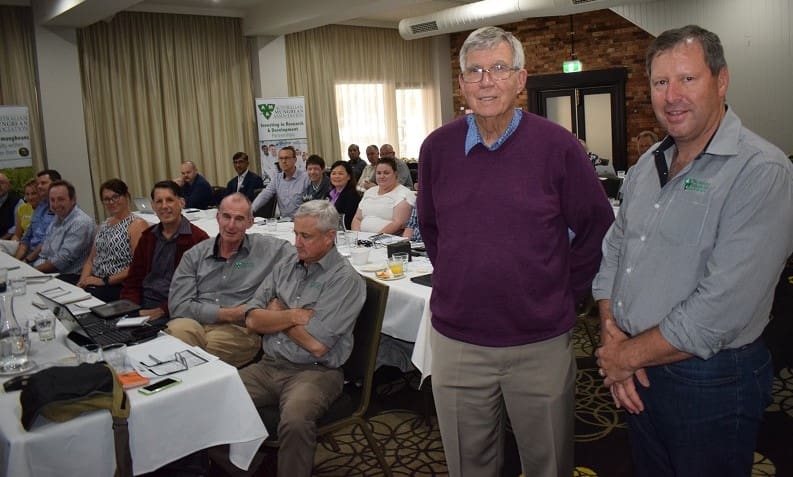
USQ Centre for Crop Health professor of crop nematology, Dr John Thompson, and AMA president, Mark Schmidt, with industry representatives at the AMA research review day in Toowoomba, Qld.
AS mungbeans transition from being simply an opportunity crop to nowadays being a mainstream summer option, researchers are turning their focus to fine tuning the yield potential of the short-season pulse.
Speaking at an Australian Mungbean Association (AMA) research review day in Toowoomba, Queensland Department of Agriculture and Fisheries (QDAF) director of crop improvement R, D and E, Dr Rex Williams, said the phenomenal growth of the mungbean industry had largely been driven by “great” research and development.
“The varieties that have come out of our breeding program have driven the reliability and confidence growers have in the industry. It has allowed the industry to take advantage of the great demand for high quality, premium products,” he said.
“In the past, the focus of research was on delivering yield gain. When mungbeans are $1000-$1400/tonne, every bit of yield puts a lot of money in growers’ pockets. Yields have been the first priority. We have had double digit yield gains all the way through.
“Now it is about protecting the yield. We are moving more to looking at things like tan spot and halo blight which are major impediments. Seed-borne diseases are a very important limitation for the industry.
“We are also diversifying, looking at the range of material and trying to understand the genetics using newer strategies such as genomic selection and nested association mapping (NAM). NAM is basically a population that helps us unravel the genetics of key traits. We are really getting into the science. Our effort is to deliver the better varieties.”
As well as the genetics, Dr Williams said the work was also looking across the research spectrum at agronomic management, pests and diseases.
“It is all part of the effort to try to narrow the yield gap between what our genetics tell us we should be able to produce and what growers produce. Mungbeans can be risky and a challenging crop to grow. There is often a yield gap. We are trying to unravel that with agronomic research to put strategies in place to help growers,” he said.
“We are also dealing with things like entomology, things like understanding Heliocoverpa mycoplasma which is a disease transmitted by a leaf hopper. It looks like it might have a particular involvement in particular seasons across a range of crops. In mungbeans it may be responsible for things like puffy pod which has been an issue in the past, and also leads to bunching of flowers.
“We are also doing work on disease, particularly on fusarium. We have work on weeds. And we have just launched a major new project in partnership with GRDC looking at some agronomic research on mungbeans in the field, working with grower groups.”
Research funding boost
GRDC northern region manager for soils, agronomy, nutrition and farming systems, Dr Kaara Klepper, said in the last six months a $5.8 million partnership between the GRDC, University of Queensland, QDAF, NSW DPI and CSIRO had been put together to advance mungbean research.
Dr Klepper said the investment was spread over a series of approaches, not just a single project.
“One part is understanding the drivers of the yield gap in mungbeans loosely based around doing a survey of growers in the 2017/18 summer trying to narrow down the factors contributing to the gap between the yield that was observed in the paddock and what the modelling had predicted for a starting soil moisture,” she said.
“That report has just been submitted. Those results have informed both the mungbean physiology project and the mungbean agronomy project, which are two separate projects that will run for the next four years.
“The mungbean physiology project is largely around understanding the response of the mungbean plant to abiotic stressed and a combination of those stresses, such as heat x moisture stress, rather than just heat stress or moisture stress. It is looking at how that plays out in the plant at different growth stages in different regions.
“The mungbean agronomy project is looking at the agronomic strategies, not just the plant-based strategies, and how the plant behaves in a different environment. It also looks at what management strategies we can use to address how you can achieve a yield reliably, but also higher yields.
“It is trying to take into account what is limiting yield, which could be AMF (Arbuscular Mycorrhizal Fungi), VAM (Vesicular Arbuscular Mycorrhizal), nematodes, nitrogen, subsoil constraints. What combinations, strategies and approaches should we have to address those things from an agronomic point of view?
“The other work is around irrigation practices. Rather than full tilt into an irrigation project, we first have to understand how the plant responds to water stress at different growth stages. So, we have to understand how growers are managing mungbeans before we go in and say they are doing it the wrong way or right way. There will be a survey for that.”
Mungbeans go mainstream
AMA president, Mark Schmidt, said the extra funding being directed to mungbean research bode well for the future of the industry.
“It is a sign that mungbeans are being recognised as one of the main summer crops and that there is a lot of value in them in a rotation from a grower’s profitability point of view. It means growers are now growing them as a regular crop, not just an opportunity crop,” he said.
Mr Schmidt said one of the projects was looking into the yield gap between the genetic potential of the varieties and what growers were achieving in the field, and determining where the yield limitations were.
“If we can lift the yield, it will make a massive difference to the total crop’s size,” he said.
“When the researchers are growing mungbean crops, they are generally growing them in better conditions, whereas when growers are planting them it is over a wide range. Most growers recognise that a crop failure comes from doing everything wrong – planting at the wrong time, not using fertiliser, not spraying and running into poor weather conditions.
“In the past, mungbeans have been seen as an opportunity crop where, when you get a shower of rain, you plant them and hope for the best. When it doesn’t turn out, they become a poor crop.
“Growers now are looking at growing them more professionally and will plant on full profiles of moisture, plant the right varieties, plant at the right time, put in fertiliser, put in the effort to spray at the right time and come up with really good crops.”
Grain Central: Get our free daily cropping news straight to your inbox – Click here





HAVE YOUR SAY